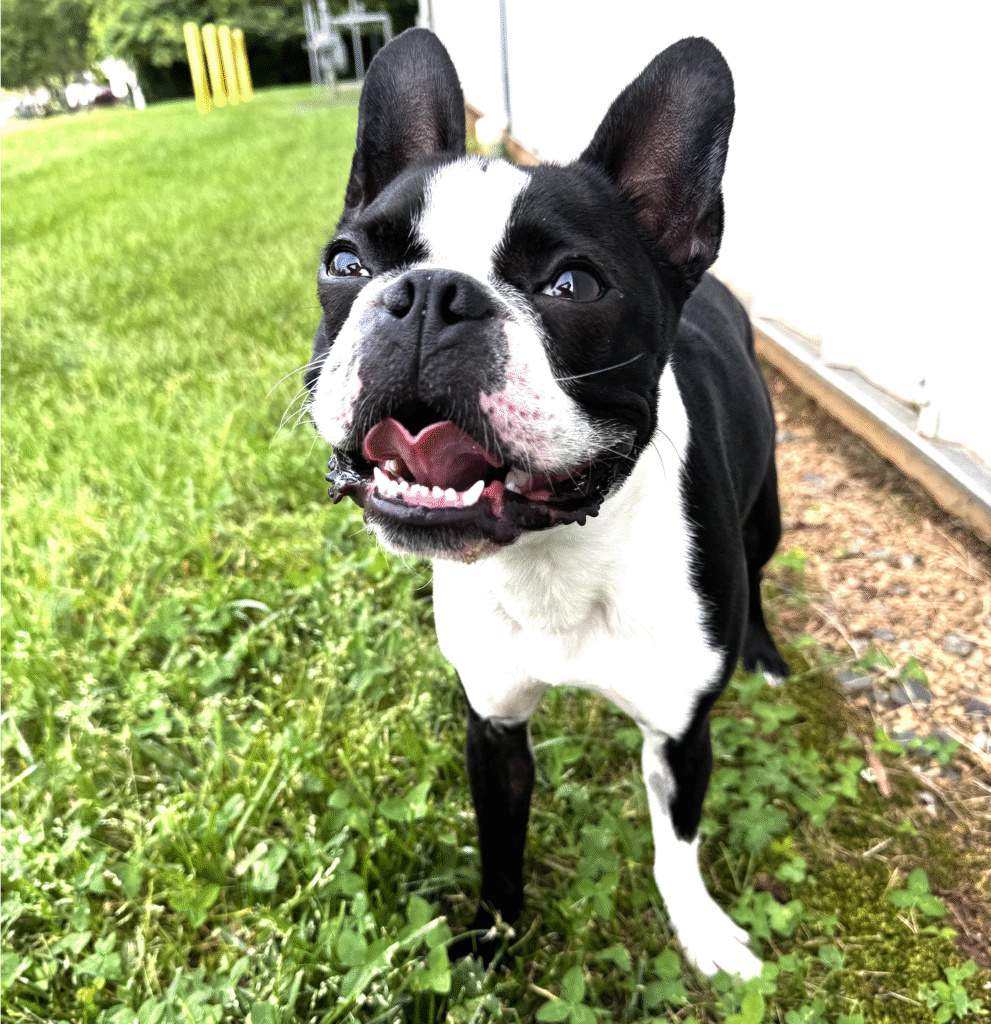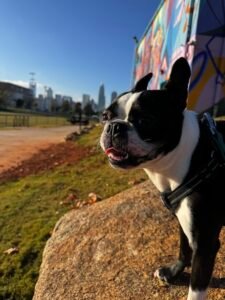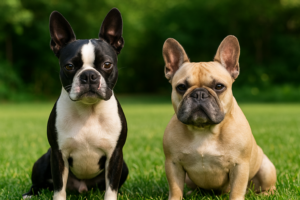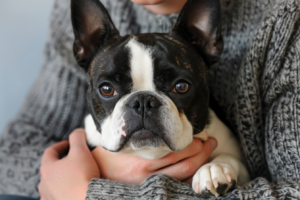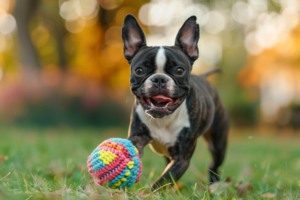Some dogs look like art in motion. My Boston Terrier, Dumpling, is one of them: a classic black-and-white gentleman whose coat reads crisp and formal indoors, like he’s wearing a tailored tux. Then we step onto the lawn at noon. The sun hits at a sharp angle, the grass throws up green light, and along his back a faint brownish shimmer appears for a moment. In softer light that glow vanishes and he’s purely black again. That tiny optical twist is why Boston’s coat colors can feel confusing in real life—and why this guide treats color the way humans see it: in rooms, on walks, and through a phone camera, not just in catalog language.
Breed Standard, Plainly Stated: What “Counts” as the Right Color
The breed standard recognizes three base colors, all with required white tuxedo markings (white blaze on the muzzle, a white band between the eyes, and a white chest; a full white “collar” and white “socks” are desirable but not mandatory). Those three allowed combinations are Black & White, Brindle & White, and Seal & White (also known as Blue Boston Terrier). This isn’t snobbery—it’s health and type baked into one recipe. Strong pigmentation supports the eyes and skin; correct structure supports the way the dog moves and breathes.
Black & White — Iconic, Photogenic, Unfussy
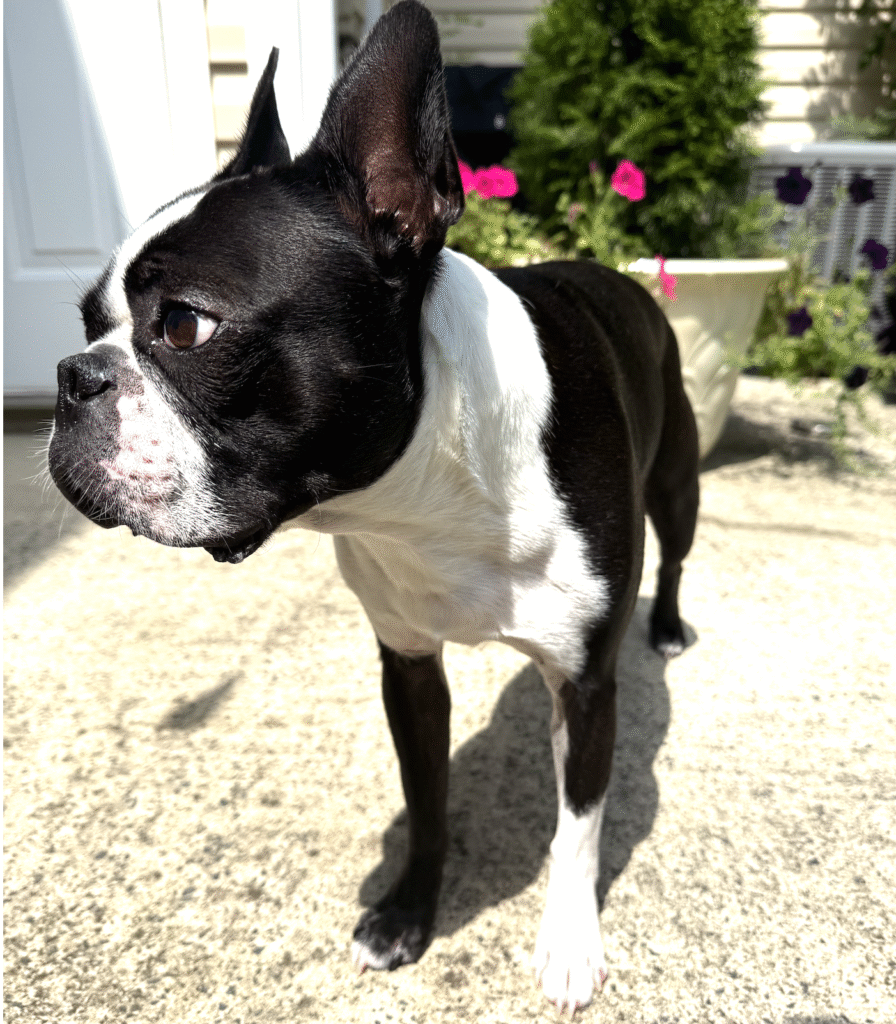
A black-and-white Boston is the poster image of the breed. The black should look truly black, with cool depth in shade and sun; the white areas sharpen the silhouette and make the square outline pop. Dumpling lives here. Indoors he’s all tux and contrast; outside he may flash that subtle warm glint on a bright day, but his nose stays black and his eye rims stay dark, which tells you his base pigment is still black. If you want a coat that photographs cleanly, ages gracefully, and needs no explanation, this is the dependable answer. In the world of Boston Terrier coloring, black & white is classic for a reason—it just works.
Brindle & White — Warm Energy, Lively Stripes, Grown-Up Depth
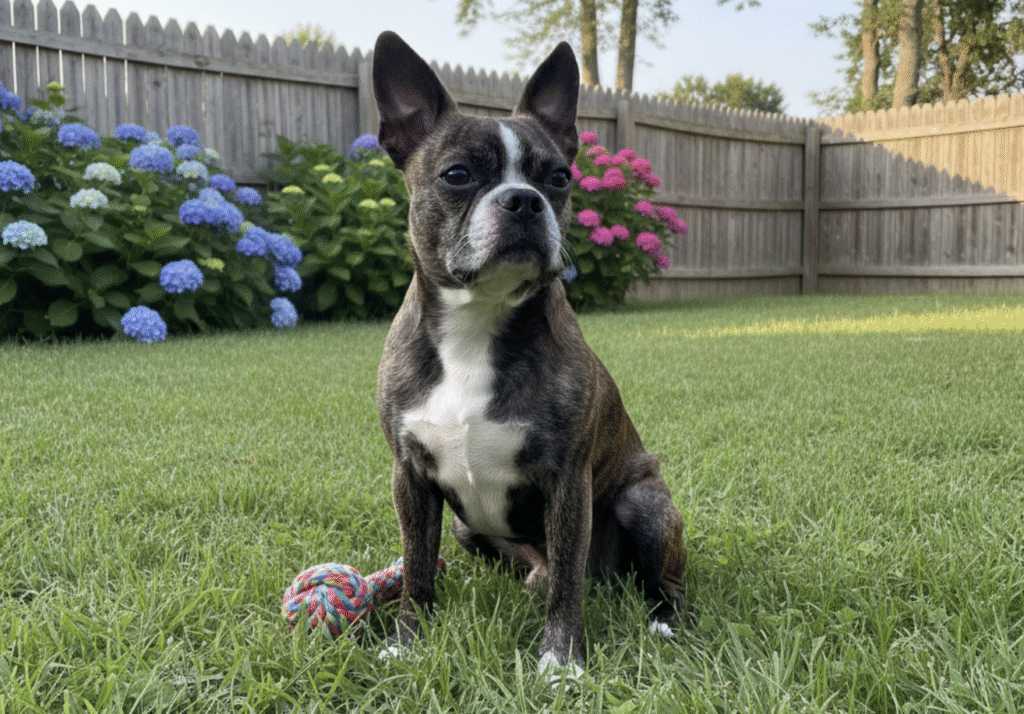
Brindle is often misunderstood. It’s not spots; it’s dark striping laid over a warm base. Some puppies look barely brindled and then “switch it on” as they mature; sunlight reveals the pattern better than indoor light. On the move, those stripes add dimension to the rib cage and croup, giving a natural sense of motion. Judges often appreciate brindle when all else is equal, partly because the pattern frames the body without drowning the tuxedo. For owners, brindle is a comforting middle ground: you stay inside the standard while enjoying a touch of warmth that suits golden-hour photos and outdoor adventures.
Seal & White — The Sunlit Secret (and the Nose Test That Saves Arguments)
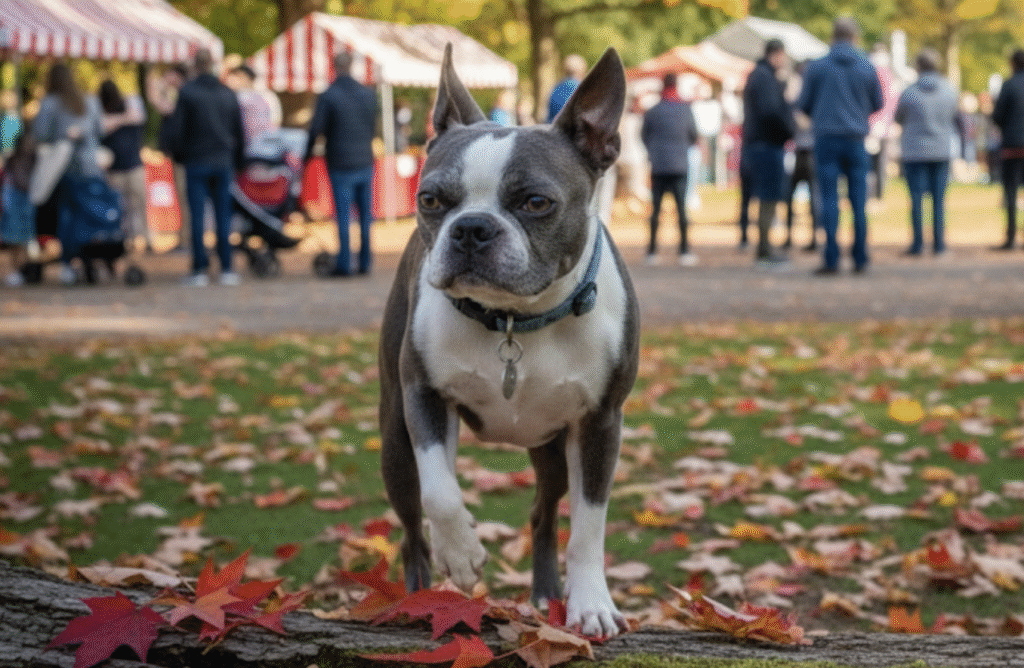
Seal looks black in shade but shows a reddish-brown sheen in strong light. That’s the trait most people trip over. The fastest way to separate seal from a true brown (sometimes called chocolate or red) is the nose test. A Boston with seal has a black nose and dark eye rims; a genetically brown Boston has a liver-colored nose and often a warmer eye. My “brown moment” with Dumpling? It’s just optics. Seal proves that light can fool the eye, while the nose tells the truth.
Genetics, Decoded Like a Conversation
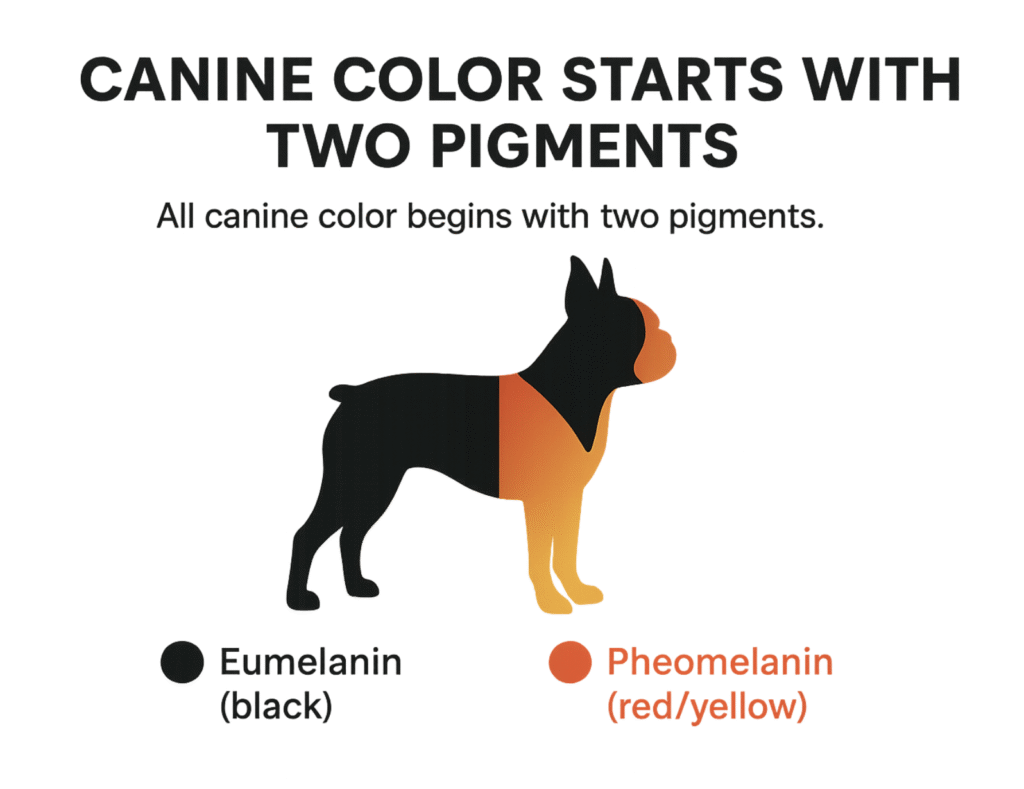
All canine color begins with two pigments: eumelanin (black) and pheomelanin (red/yellow). Several “switches” decide what we actually see. The K-locus is the big lever: KB sets a black base (so black, seal, and the possibility of brindle live here), kbr allows brindle striping, and ky lets the red/yellow family show (not part of the Boston standard). The B-locus mutates black into brown when it’s bb—that’s why the nose turns liver. The D-locus modifies intensity; dd dilutes pigment so black looks blue and brown looks lilac/isabella. The S-locus places the white tuxedo markings. Put together, those levers explain why a Boston Terrier’s coat color can look sturdily classic—or drift into fashionable but non-standard territory.
The Unofficial Spectrum: Pretty, Marketed, and Often Problematic
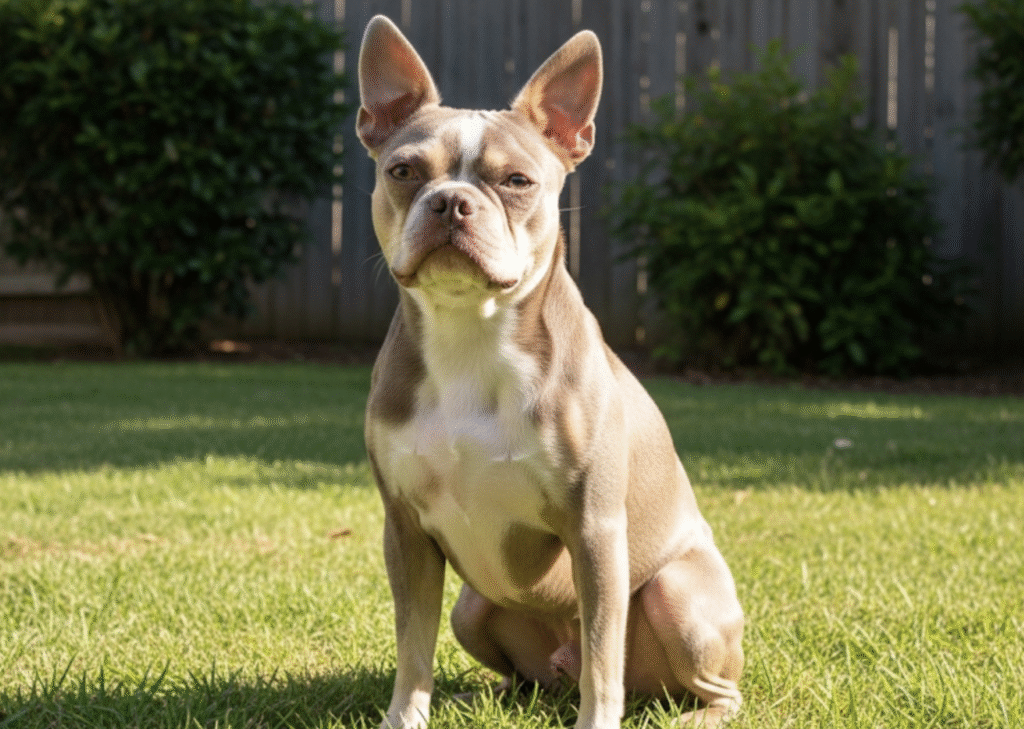
There’s a parallel market for colors outside the standard. You’ll see brown/red/chocolate (bb), blue (dd), lilac/champagne (bb dd), plus fawn/cream, and even merle. These names sound glamorous, but they’re just shorthand for specific genetic combos. Beauty isn’t a crime; selling rarity as the main value is the red flag. Ask why the color was used, what health testing was done, and whether the breeder can show parents in shade and sun. If your goal is a healthy companion and an honest Boston outline, the standard palette remains the safest long game.
A tiny, useful list (and then we go back to prose)
- Brown/“red” (bb): warm coat, liver nose; not standard.
- Blue (dd): steel-gray cast, gray/blue nose; not standard.
- Lilac (bb dd): pale beige-lilac, lilac nose; not standard.
- Fawn/Cream: pheomelanin-based shades; not standard.
- Merle: a marbled pattern from a gene not native to the breed; high concern in “double merle” pairings.
Health Consequences of Non-Standard Colors: Clear-Eyed, Not Alarmist
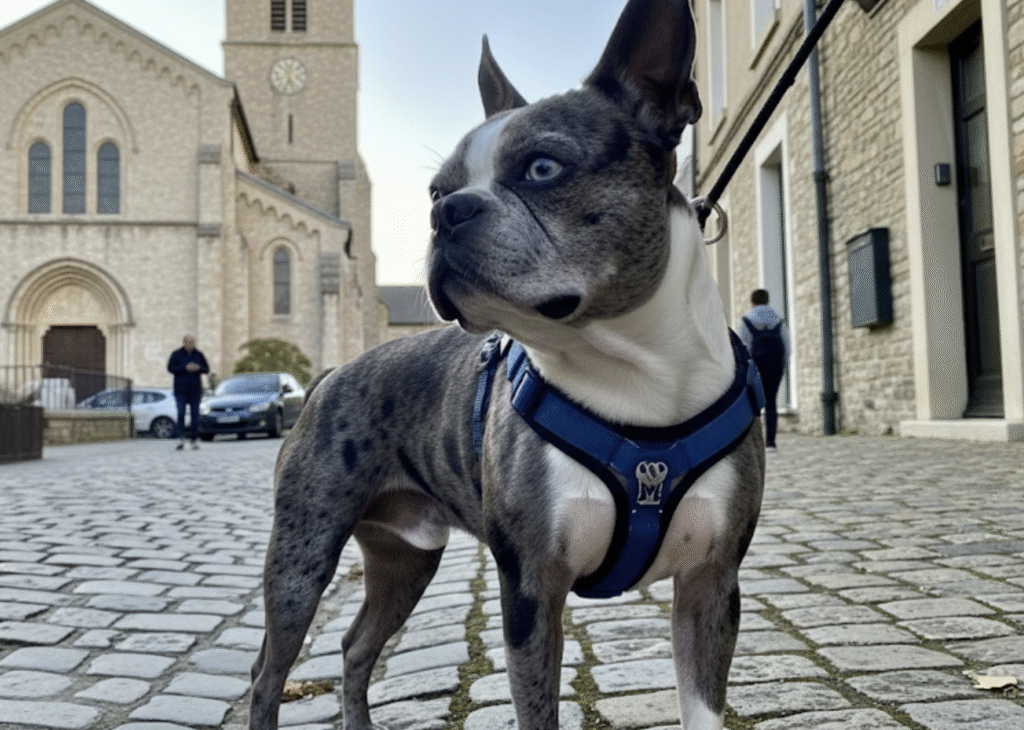
Color by itself doesn’t doom a dog, but some pigment routes raise the odds of issues. Dilute colors (dd) are tied more often to Color Dilution Alopecia (CDA)—brittle hair, patchy thinning, skin that needs thoughtful, ongoing care. Merle, especially double merle, is frequently associated with serious vision and hearing problems. Could an individual dog do fine? Yes. Are the risks your wallet, schedule, and heart must manage if luck breaks the other way? Also yes. When you weigh the colors of Boston Terriers, put health and routine at the top of the scale.
Albinism Isn’t “Very White”—It’s No Pigment at All
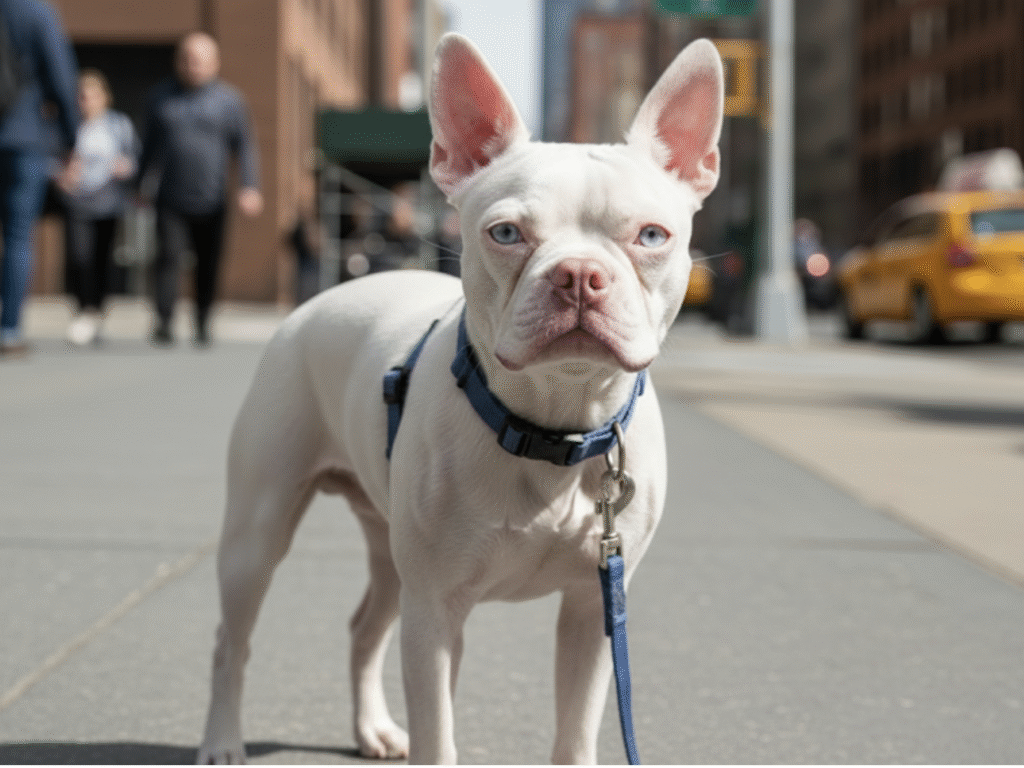
Albinism is a rare, distinct condition where melanin production is profoundly reduced or absent. The dog may have white/cream hair, pink skin, very light eyes, and notable light sensitivity. That’s different from a very white Boston produced by extreme white spotting (heavy white from the S-locus), where pigment exists but the white areas overwhelm the picture. People also mix this up with congenital deafness, which is more closely tied to pathways that suppress melanocytes (like merle or heavy white), not albinism itself. If you’re unsure, ask your vet and consider a BAER hearing test instead of guessing in the comments section.
Field Clarity: Standard vs. Fashion — a Quick Comparison
| Coat color (everyday words) | How it really looks | Nose/Eye rims | Show status | Care notes |
|---|---|---|---|---|
| Black & White | Cool, deep black with bright tuxedo white; stable in most light | Black nose, dark rims | Standard | Easy to photograph; timeless |
| Brindle & White | Warm base with dark striping; pattern strengthens with age/sun | Black nose | Standard | Pattern “comes alive” outdoors |
| Seal & White | Black in shade; reddish sheen in strong light | Black nose | Standard | Often misread as brown; use the nose test |
| Brown/Red (bb) | From chocolate to coppery | Liver nose | Non-standard | Aesthetic, not breed-typical |
| Blue (dd) | Steel-gray | Gray/blue nose | Non-standard | Higher CDA risk reported |
| Lilac (bb dd) | Pale beige-lilac | Lilac nose | Non-standard | Similar CDA concern |
| Merle | Marbled patches | Variable | Non-standard | Gene not native; double merle risk for hearing/vision |
How Color Warps Price: The Brutal Economics of “Rare”
Here’s the paradox. The farther a coat gets from the standard, the louder the “rare!” label and the higher the price can climb—even when health testing is lighter and show eligibility is zero. Meanwhile, classic standard coats from health-first, show-savvy programs may cost less than “exotics,” despite deeper testing and clearer contracts. If you’re comparing Boston Terriers’ coat colors for a puppy purchase, compare value, not just price: parental health certifications, BAER where relevant, transparent pedigrees, and a breeder who answers “why this color?” with something better than marketing.
Price Ranges by Breeder Type and Color Category (USA)
| Breeder Type | Color Category | Typical Price (USD) | What You’re Paying For |
|---|---|---|---|
| Preservation/Show program | Standard (black, brindle, seal) | $2,000 – $4,000+ | Extensive health testing, proven structure/temperament, conformity to the standard |
| Color-focused program | Non-standard (brown/red, blue) | $2,500 – $4,500+ | “Rarity” as the headline; health testing can be thinner |
| “Exotic” color seller | Non-standard exotic (lilac, merle) | $3,000 – $6,000+ | Exclusivity and hype; higher risk profiles (CDA, merle-related issues) |
| Casual/online marketplace | Any color | $600 – $1,800 | Minimal testing, uncertain lineage; highest buyer risk |
How to keep your Boston Terrier’s coat naturally shiny (Dumpling’s simple routine)
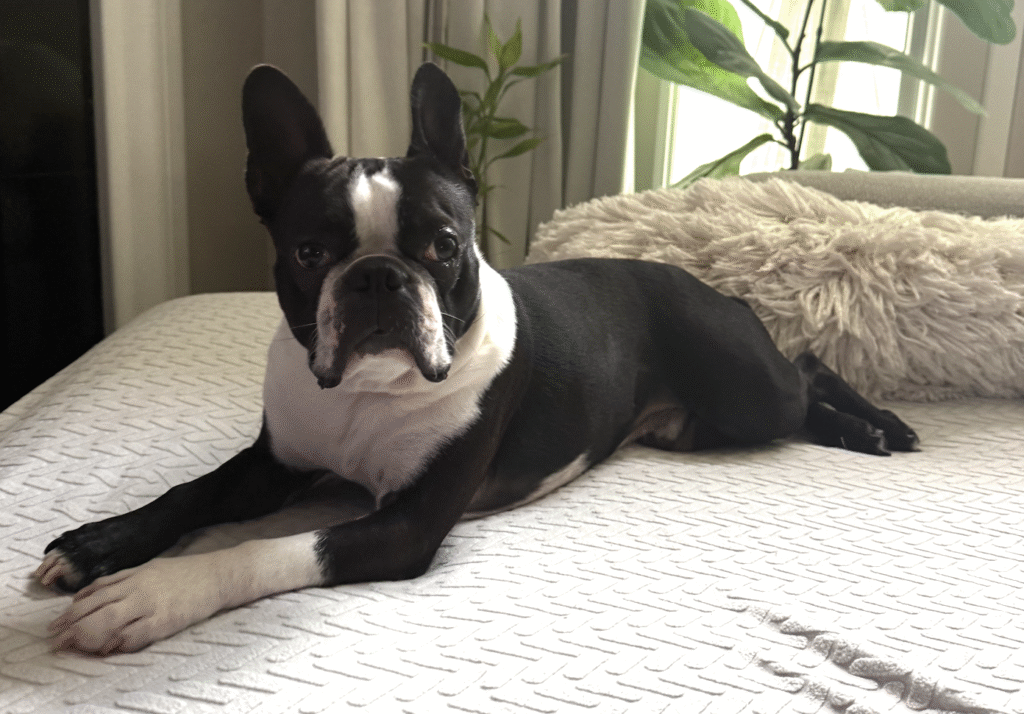
A healthy shine comes from small habits you can repeat without thinking. With Dumpling, three things make the biggest difference: a touch of marine omega-3s in his diet, gentle baths with a real conditioner, and a quick daily brush with a soft rubber tool.
1) Food first (a little omega-3 goes a long way)
I don’t chase fancy powders. I add a small, measured pump of fish oil (EPA/DHA) to dinner for a few weeks, then take a break and watch his skin and stool. If everything looks good, we keep the habit. The goal isn’t “greasy gloss”—it’s calm skin and a soft, even coat. Start low, ask your vet for a sensible dose, and let the diet do the quiet work.
What’s worked for us:
- Grizzly Salmon Oil (liquid, easy to measure)
- Nutramax Welactin (liquid, vet-friendly)
- If oil isn’t your dog’s thing: omega-3 soft chews can be easier
2) Bathe less, condition more
Short coats still dry out. I bathe Dumpling every 3–4 weeks (or when he actually needs it) with a mild, pH-balanced shampoo and always finish with an oatmeal/aloe conditioner to seal the cuticle. I do a brief cool rinse at the end and pat dry with a towel—no harsh rubbing. Between baths, a quick wipe of chest and paws is plenty; if the air is dry, a light leave-in mist keeps the jacket supple. And don’t forget a treat after the bath!
We like: earthbath Oatmeal & Aloe Conditioner (and the matching shampoo if you want a set)
3) One minute of brushing, every day
A soft rubber curry/ZoomGroom in small circles lifts dust, spreads natural oils, and gives that just-polished look without effort. It’s gentle enough for daily use and doubles as a bath tool to work in the shampoo.
Tool that never disappoints: KONG ZoomGroom (or any similar rubber curry)
Quick fixes when the shine goes missing
- Dry flakes or itch: stretch the time between baths, bring back the conditioner, and add a short omega-3 cycle.
- Dull after bathing: use a gentler shampoo, finish with a cool rinse, and blot—don’t scrub—dry.
- Fishy smell: reduce the oil dose and store the bottle tightly closed in a cool spot.
- Static indoors: a touch of leave-in, shorter hot showers, or even a room humidifier can help.
Smart, Kind, Practical: A Closing Note from Dumpling’s Lawn
If you want everyday joy, pick a color that won’t pick fights with reality. A Boston Terrier’s coat color in the standard trio—black, brindle, or seal, all with tuxedo white—delivers predictability, strong pigment, and that unmistakable Boston outline. Non-standard coats can look striking, but they often ask more of your time, budget, and nerves. I adore Dumpling’s classic look because it never argues with the light; it simply absorbs it, reflects a little magic, and goes back to being the dog I came outside to love.
FAQ
-
What is the rarest Boston Terrier color?
If you mean non-standard colors (the ones not accepted for the show ring), the rarest you’ll usually hear about is “lilac”—that’s a double-diluted brown (genetically bb dd). It looks pale beige-lilac and comes with a lilac nose. True albinism is rarer still but isn’t a recognized coat color and brings real care needs (light sensitivity, skin protection).
Within the standard palette—Black & White, Brindle & White, Seal & White—you’ll typically see black most often, brindle fairly often, and seal a bit less. “Seal” can be overlooked because indoors it reads black; only in bright sun do you notice that warm, reddish sheen.
My take: rarity isn’t a value by itself. I love Dumpling’s classic black-and-white color because it looks great in every light, ages well in photos, and matches the breed standard. If you’re tempted by “rare,” pause and ask about health testing, parent photos in shade and sun, and whether the breeder can explain the genetics without marketing buzzwords. -
Are Boston Terriers red or brown?
People say “red”, but in genetics we’re talking brown (liver). The giveaway is the nose: brown Bostons have a liver-colored nose (and often a warmer eye). That’s different from seal, which also looks warm in sunlight but keeps a black nose and dark eye rims.
Why the mix-up? Sunlight can pull warm tones out of dark coats. My Dumpling sometimes flashes a brownish shimmer on the lawn at noon; indoors he’s purely black. That shimmer makes owners think “red,” but the nose test clears it up in two seconds.
Friendly tip: if you love the look of brown, know it’s non-standard for the breed and may limit show options. That doesn’t make a brown Boston a “bad dog,” just a different choice. Ask the breeder “why this color?” and make sure the answer is better than “because it’s rare.” -
What color is a seal Boston Terrier?
Seal is the chameleon of the breed. In the shade, the dog appears black; in strong light, the coat shows a reddish-brown sheen along the back or shoulders. The quick way to confirm seal is the nose test: seal keeps a black nose and dark eye rims.
Owners often discover seal the first sunny day after bringing a puppy home. You’ll take a photo, zoom in, and think, “Wait, is that brown?” It’s the same phenomenon I see on Dumpling when the sun is high: a warm glint that vanishes indoors.
How to check at home: step into open shade (reads black), then into bright sun (look for a subtle warm cast). If the nose is black in both lighting situations, you’re almost certainly looking at seal, not brown. It’s a standard, show-eligible color. -
What colors are Boston Terriers not allowed to be?
For the show ring, anything outside the trio—Black & White, Brindle & White, Seal & White—is not allowed. That includes brown (“red”/liver), blue (dilute black), lilac/isabella/champagne (double dilute brown), fawn/cream, merle, and solid coats without the required white tuxedo markings.
Also disqualifying in most standards: blue eyes or any blue in the eyes, a flesh-colored (Dudley) nose, and a docked tail. Remember, the “tuxedo” isn’t optional—there must be a white blaze on the muzzle, white between the eyes, and a white chest; the full “collar” and white socks are desirable but not mandatory.
Kind reminder: show rules don’t define who makes the best pet. A non-standard color Boston can be a wonderful companion; just go in with clear eyes about health, ethics, and what you want to do with your dog. -
What is a lilac Boston Terrier?
“Lilac” is breeder shorthand for a double-diluted brown (genes bb dd). Black pigment is first changed to brown (liver), then diluted, which shifts the coat to a pale beige-lilac and the nose to lilac as well. It’s often marketed as “rare” or “exotic,” but it is non-standard for the breed.
A practical note for owners: dilute colors (blue, lilac) are more frequently linked with color-dilution alopecia (CDA)—coat that’s brittle or thins in patches, plus skin that needs extra management. Not every dilute dog has problems, but the odds move in that direction.
What to ask a seller: “What health testing have the parents had?” “Do you have photos in shade and bright sun?” and “If skin issues happen, what’s your support plan?” Curiosity now is cheaper than dermatology later. -
Do non-standard colors change the price?
Often yes. Many sellers charge more for “rare” non-standard coats than preservation breeders do for standard, fully-health-tested puppies. It’s the paradox of hype: higher risk and higher price can travel together. If you’re shopping, compare value, not just number of dollars—tests, contract, socialization, and honest answers about color.


